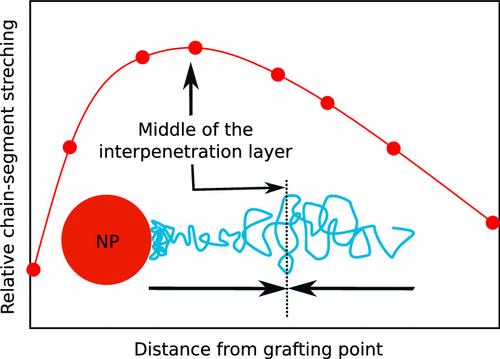Structure and Dynamics of Polymer Segments in Polymer-Grafted Nanoparticle Melts
IF 5.2
1区 化学
Q1 POLYMER SCIENCE
引用次数: 0
Abstract
We present an extensive coarse-grained molecular dynamics study of polymer-grafted nanoparticle (GNP) melts, focusing on the structure and dynamics of the grafted polymers by systematically varying grafting density and chain length. Consistent with theoretical predictions from the recently established two-layer GNP model, we observed the formation of a self-monomer-rich dry layer near the nanoparticle (NP) surface that limits interchain mixing from neighboring GNPs. Beyond this region, an interpenetration layer forms with significant chain mixing. At fixed chain length, the degree of interchain mixing decreases with increasing grafting density, leading to a more extended dry layer at the expense of the interpenetration layer. Segmental analysis shows pronounced chain stretching within the dry layer, while segments adopt coil-like conformations within the interpenetration layer. At high grafting densities, the relative stretching of chain segments becomes nonmonotonic, with a maximum near the center of the interpenetration layer. The bond vector autocorrelation function, which probes segmental dynamics, exhibits a saturation plateau for bonds near the NP surface, reflecting persistent confinement and restricted mobility due to the dense grafting environment. This plateau gradually disappears with an increasing distance of the bonds from the NP surface, and the bond dynamics instead exhibits a power-law decay characteristic of Rouse dynamics in bulk polymer melts. These findings highlight the spatially heterogeneous nature of chain conformations and mobility within the grafted corona.

聚合物接枝纳米颗粒熔体中聚合物段的结构和动力学
我们对聚合物接枝纳米颗粒(GNP)熔体进行了广泛的粗粒度分子动力学研究,通过系统地改变接枝密度和链长,重点研究了接枝聚合物的结构和动力学。与最近建立的双层GNP模型的理论预测一致,我们观察到纳米颗粒(NP)表面附近形成了一个自富单体的干层,限制了邻近GNPs的链间混合。在此区域之外,形成穿透间层,并伴有明显的链混合。在链长固定的情况下,随着接枝密度的增加,链间混合程度降低,导致干层的延伸,而渗透层的延伸则减少。段状分析显示干层内链状伸展明显,侵穿层内段状呈卷状构象。在高接枝密度下,链段的相对拉伸是非单调的,在接枝层中心附近达到最大值。探测段动力学的键向量自相关函数显示,NP表面附近的键存在饱和平台,反映了密集接枝环境导致的持续约束和受限迁移。随着键与NP表面距离的增加,这个平台逐渐消失,而键动力学在大块聚合物熔体中呈现出劳斯动力学的幂律衰减特征。这些发现突出了链构象和移动性在接枝电晕内的空间异质性。
本文章由计算机程序翻译,如有差异,请以英文原文为准。
求助全文
约1分钟内获得全文
求助全文
来源期刊

Macromolecules
工程技术-高分子科学
CiteScore
9.30
自引率
16.40%
发文量
942
审稿时长
2 months
期刊介绍:
Macromolecules publishes original, fundamental, and impactful research on all aspects of polymer science. Topics of interest include synthesis (e.g., controlled polymerizations, polymerization catalysis, post polymerization modification, new monomer structures and polymer architectures, and polymerization mechanisms/kinetics analysis); phase behavior, thermodynamics, dynamic, and ordering/disordering phenomena (e.g., self-assembly, gelation, crystallization, solution/melt/solid-state characteristics); structure and properties (e.g., mechanical and rheological properties, surface/interfacial characteristics, electronic and transport properties); new state of the art characterization (e.g., spectroscopy, scattering, microscopy, rheology), simulation (e.g., Monte Carlo, molecular dynamics, multi-scale/coarse-grained modeling), and theoretical methods. Renewable/sustainable polymers, polymer networks, responsive polymers, electro-, magneto- and opto-active macromolecules, inorganic polymers, charge-transporting polymers (ion-containing, semiconducting, and conducting), nanostructured polymers, and polymer composites are also of interest. Typical papers published in Macromolecules showcase important and innovative concepts, experimental methods/observations, and theoretical/computational approaches that demonstrate a fundamental advance in the understanding of polymers.
 求助内容:
求助内容: 应助结果提醒方式:
应助结果提醒方式:


